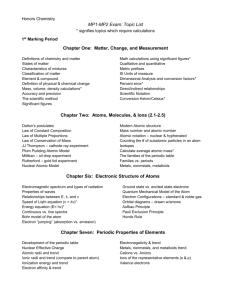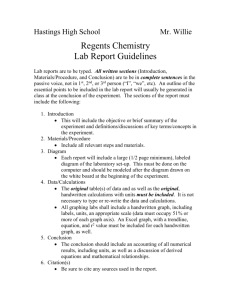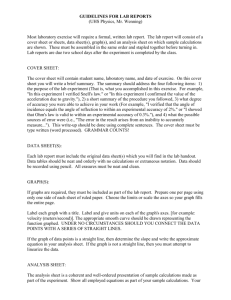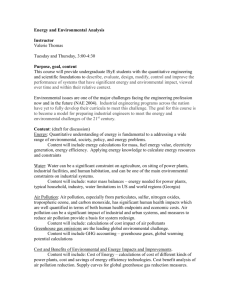Honors Chemistry 27 Week Assessment – Topics List Date
advertisement
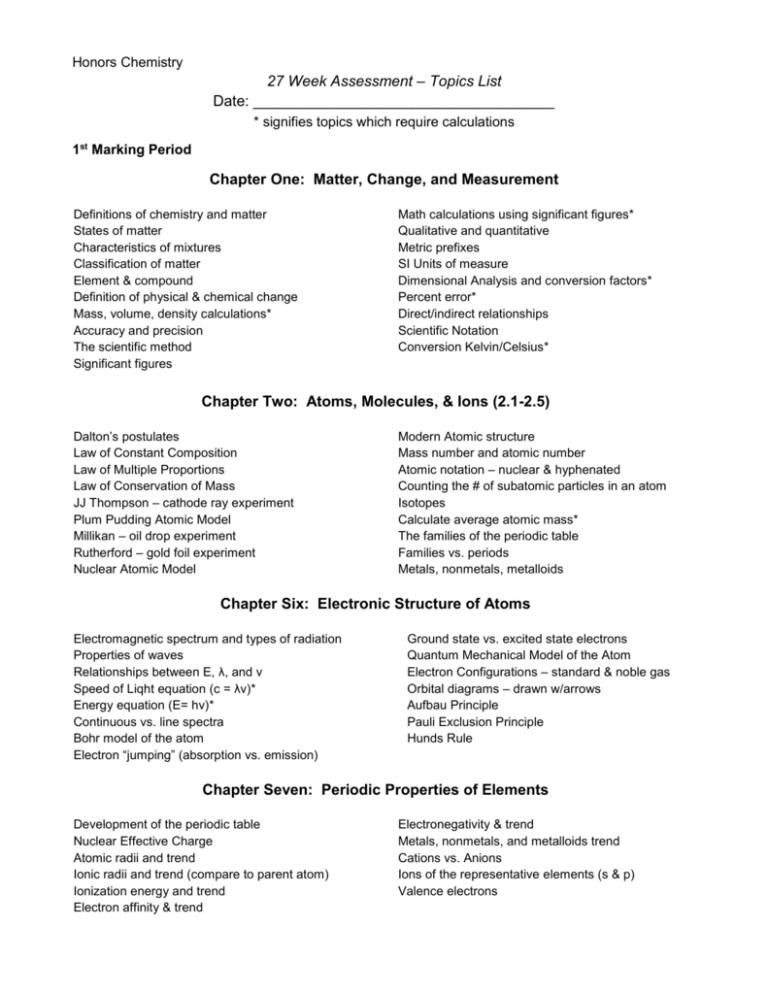
Honors Chemistry 27 Week Assessment – Topics List Date: ____________________________________ * signifies topics which require calculations 1st Marking Period Chapter One: Matter, Change, and Measurement Definitions of chemistry and matter States of matter Characteristics of mixtures Classification of matter Element & compound Definition of physical & chemical change Mass, volume, density calculations* Accuracy and precision The scientific method Significant figures Math calculations using significant figures* Qualitative and quantitative Metric prefixes SI Units of measure Dimensional Analysis and conversion factors* Percent error* Direct/indirect relationships Scientific Notation Conversion Kelvin/Celsius* Chapter Two: Atoms, Molecules, & Ions (2.1-2.5) Dalton’s postulates Law of Constant Composition Law of Multiple Proportions Law of Conservation of Mass JJ Thompson – cathode ray experiment Plum Pudding Atomic Model Millikan – oil drop experiment Rutherford – gold foil experiment Nuclear Atomic Model Modern Atomic structure Mass number and atomic number Atomic notation – nuclear & hyphenated Counting the # of subatomic particles in an atom Isotopes Calculate average atomic mass* The families of the periodic table Families vs. periods Metals, nonmetals, metalloids Chapter Six: Electronic Structure of Atoms Electromagnetic spectrum and types of radiation Properties of waves Relationships between E, λ, and ν Speed of Liqht equation (c = λν)* Energy equation (E= hν)* Continuous vs. line spectra Bohr model of the atom Electron “jumping” (absorption vs. emission) Ground state vs. excited state electrons Quantum Mechanical Model of the Atom Electron Configurations – standard & noble gas Orbital diagrams – drawn w/arrows Aufbau Principle Pauli Exclusion Principle Hunds Rule Chapter Seven: Periodic Properties of Elements Development of the periodic table Nuclear Effective Charge Atomic radii and trend Ionic radii and trend (compare to parent atom) Ionization energy and trend Electron affinity & trend Electronegativity & trend Metals, nonmetals, and metalloids trend Cations vs. Anions Ions of the representative elements (s & p) Valence electrons 2nd Marking Period Chapter Two: Chemical Names & Formulas (2.6-2.9) Polyatomic ions - name, formula, and charge Name ionic compounds Write formulas for ionic compounds Name covalent compounds with prefixes Write formulas for covalent compounds Distinguish between ionic and molecular Chapter Three: Chemical Reactions & Stoichiometry 5 types of chemical reactions Balancing chemical equations Writing and balancing word equations Formula weight and percent composition* Determining molecular and empirical formulas* Stoichiometric calculations & molar conversions* Conversions: grams, mols, atoms, & molecules Use molar mass & Avogadro’s # Limiting and excess reactant problems* Percent yield calculations* Chapter Four: Aqueous Reactions Soluble vs. Insoluble Using the solubility rules Electrolytes – strong, weak, or non Double replacement reactions Predict the products & states of matter Determine if a precipitate was formed Single replacement redox reactions Using the activity series of metals & halogens Determine if the reaction can occur Predict the products & balance Writing complete & net ionic equations Determining spectator ions Chapter Eight: Chemical Bonding Ionic vs. Covalent bonding Bond polarity & difference in electronegativity Polar vs. Nonpolar bonds Single, double, & triple bonds Relationship – bond length, strength, & enthalpy Drawing Lewis structures Octet Rule & exceptions to the octet rule Resonance structures Chapter Nine: Molecular Geometry & Bonding Theories VSEPR Theory Determining molecular geometry of a compound Determining polarity of an entire molecule 3rd Marking Period Chapter Five: Thermochemistry Endothermic vs. Exothermic Convert between energy units (cal, kcal, J, kJ)* Specific heat and calorimetry calculations* Thermochemical equations (endo or exo?) Using thermochemical equations to calculate heat absorbed or released (dimensional analysis)* Enthalpy Diagrams (endo or exo?) Hess’s Law & calculations* Calculating enthalpy of reaction (ΔHrxn) from Hf° Chapter Eleven: IMFs & States of Matter States of Matter (molecular view) Heating Curves plateaus vs. sloped segments changes in kinetic or potential energy? Phase Changes Phase Diagrams Intermolecular Forces (def. & strongest/weakest) London dispersion, dipole-dipole, hydrogen bonding, ion-dipole Properties of liquids (viscosity, surface tension, capillary action) Vapor pressure & VP curves Chapter Ten: Gases Gas Laws & calculations (Charles’s, Boyle’s, GayLussacs, Avogadro’s, Combined)* Ideal Gas Law calculations: PV = nRT* Rearranging the ideal gas law to calculate mass, molar mass, and density* Ideal Gas Law & stoichiometry calculations* What are the conditions of STP? Molar volume relationship at STP (1 mole = ? L) Dalton’s Law & partial pressure calculations* Collecting a gas over water Diffusion & effusion of a gases (speeds of) Chapter Thirteen (and 4.5): Solutions Molarity calculations* Dilution Calculations: M1V1 = M2V2* Concentration of ions in solution* Solubility curves Unsaturated, saturated, & supersaturated Factors that affect solubility of solids & gases Molality, mole fraction, & mass % calculations*
